Getting Around, Lima Travel, Transport and Car Rental
(Lima, Peru)
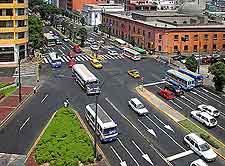
An enormous transport hub with connections spanning much of
Peru, Lima is the place to base yourself if you want to travel. Being relatively central in Peru, backpackers and travellers can take full advantage of Lima's proximity to highways.
Around the city of Lima itself, public transport comes in a number of guises. Many tourists choose to travel by bus or microbus (micros and combis), as well as shared 'colectivo' taxis. This privately owned bus transport is very cheap, although not always especially reliable.
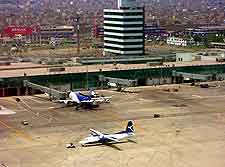
Jorge Chavez International Airport (LIM) / Arriving by Air
Address: Elmer Faucett Avenue / Nestor Gambretta, Callao, Lima, Peru, PE
Tel: +51 01 517 3100
Peru's premier air facility, the
Jorge Chavez International Airport is a mere 16 km / 10 miles to the north-west of central Lima and serves 12 million plus travellers each year. The airport features regular flights all around the world, with excellent links to
South America, and to popular international cities such as
Amsterdam,
Atlanta,
Houston,
Los Angeles,
Madrid,
Miami,
New York and
Toronto. Domestic flights are also readily available from Lima, travelling to the Peruvian cities of Andahuaylas,
Arequipa,
Ayacucho, Cajamarca,
Chiclayo,
Cusco,
Huancayo,
Iquitos, Pucallpa, Tarapoto and also
Trujillo.
Jorge Chavez International Airport (LIM) Guide
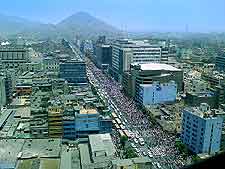
Car Rental
By road, Lima offers very good connections to much of Peru, thanks in no small part to its proximity to the Pan-American Highway (Panamericana Sur) and also the Central Highway (Carretera Central). The Pan-American Highway travels in a north-south direction, close to the coastline, and if you head south you will pass Los Claveles, Chira, Punta Negra, San Bartolo, Playa Honda, San Andres, Mala, Bujama Baja, La Capilla, Cerro Azul, Chinca Alta, San Aurelio and Pisco. Travel north on the Pan-American Highway from Lima and you will encounter Puenta Piedra, Santa Rosa, Chancay, Garita Dona Maria and Campamento, and ultimately
Chimbote, Trujillo, Chiclayo,
Piura, Sullana and Tumbes, close to the border with Ecuadaor. Car rental in Lima is therefore a very useful mode of transport, although if you don't feel quite brave enough to drive yourself around, then consider hiring a car or taxi with your very own personal driver.
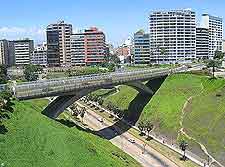
Buses and Coaches
Local minibuses in Lima are known locally as 'micros' (large) or 'combis' (small), and together with larger buses make up the most popular public transport on offer in the city. However, whilst minibuses are without doubt a very cheap way to travel around Lima, they are slow and often extremely crowded, which to backpackers is all part of the Peru experience. The windscreens usually display a destination card, so you can be confident where you are travelling to. Notable bus routes in Lima connect the city centre with the Barranco and Miraflores neighbourhoods, along the Paseo de la Republica or the Avenida Arequipa, and also run between the Plaza Grau and the Paseo de la Repubblica. Bus transport regularly plies the Pan-American Highway, reaching many of the leading tourist hotspots, such as Ica and Nazca to the south.
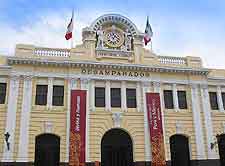
Trains and Metro
Between April and October, the famous Ferrocarril Central Andino railway line travels from Lima's Estacion Desamparado train station and heads inland to Huancayo, reaching a height of more than 4,800 metres / 15,750 feet above sea level, a height which makes this passenger train the world's second-highest of its kind. The luxurious Hiram Bingham train travels between Lima and the Puente Ruinas train station in Aguas Calientes, next to
Machu Picchu.
A relatively recent addition to public transport in the city is the Lima Metro, a urban electric train which operates around the southerly districts and currently stops at seven stations along its 10-km / 6-mile track. Further lines and stops are planned for the near future.
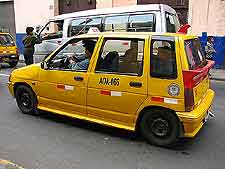
Taxis
Those choosing to use taxi transport in Lima will find this a surprisingly inexpensive way to travel around. Taxis do not have any actual meters, and so it is very important that you first agree a price before you step in, and don't be afraid to try your hand at a spot of haggling. You can easily flag taxis down on the street and head to the innumerable museums and other places of interest. At night, taxis tend to be more expensive, especially if you are travelling to the airport. Bear in mind that a staggering one in seven cars in Lima now operates as a taxi, so do try to only use the official taxis cabs - those with a sign on the roof. Colectivo taxis are amongst the cheapest options.
 An enormous transport hub with connections spanning much of Peru, Lima is the place to base yourself if you want to travel. Being relatively central in Peru, backpackers and travellers can take full advantage of Lima's proximity to highways.
An enormous transport hub with connections spanning much of Peru, Lima is the place to base yourself if you want to travel. Being relatively central in Peru, backpackers and travellers can take full advantage of Lima's proximity to highways.




